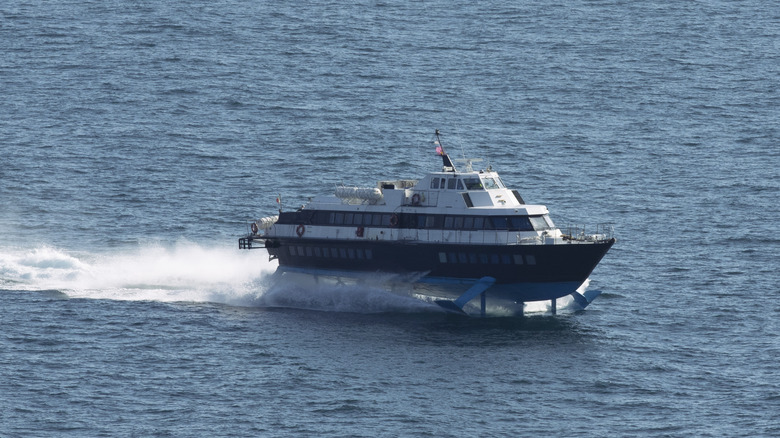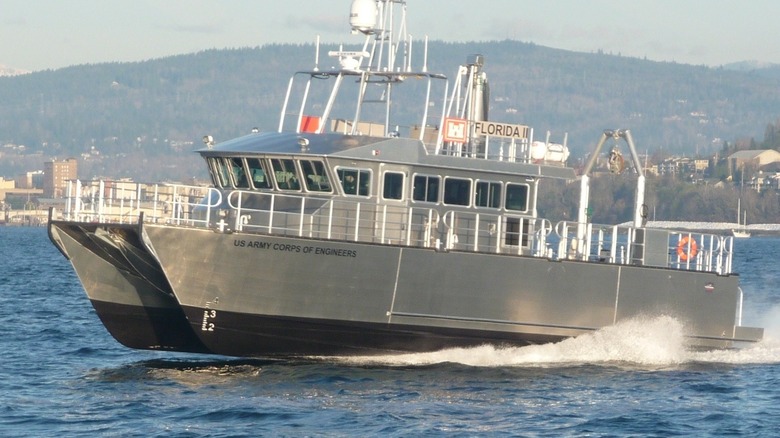The Reason Why The US Military Doesn't Use More Hydrofoil Ships
Boats have come a very long way indeed since humanity discovered that simple wooden constructions were convenient ways to cross swaths of water. The majestic cruise ships of today are essentially floating hotels: according to Yahoo News, Icon of the Seas, Royal Caribbean's upcoming behemoth, will be the world's largest, just short of a staggering 1,200 square feet in size.
While such ships will be fully equipped with every mod-con that thousands of holidaymakers could desire, military ships are replete with technology of a very different sort. This isn't to say, of course, that size and spectacle haven't been key features of the U.S. military's ships too. Indeed, the USS Gerald R Ford, of the U.S. Navy, is the world's biggest aircraft carrier, measuring 1,100 square feet itself. The Navy certainly continues to innovate with its aircraft carriers too.
At times in its history, however, much smaller and rather more unique Navy vessels have been deployed too. Hydrofoils — ships with wings that help lift them out of the water — have rarely been used, however, and there are some pertinent reasons why.
Hydrofoils and the U.S. Military
Hydrofoil ships boast some advantages that would make them quite practical from a military perspective. Using the "fin" that is the foil, they are able to essentially rise out of the surface of the water. By so doing, a boat is less beholden to the effect of the surrounding water, which results in smoother movements and higher speeds.
The result is a small, agile ship that can make quick, precise movements. Such qualities, of course, have a lot of potential utility in a military capacity in particular. Sometimes, after all, something more subtle than an enormous warship is necessary.
In the past, the U.S. Navy has used hydrofoils. According to Naval History and Heritage Command, the tremendous threat posed by submarines in the 1960s saw the seafaring service introduce a series of powerful, maneuverable hydrofoils. The first of these was USS High Point, which boasted a trio of submerged hydrofoils. The High Point opened the door for a class of Pegasus-series of hydrofoil ships. This class of ships, Popular Mechanics reports, could reach 48 knots at full speed, powered by its foils and General Electric LM2500 gas turbine.
They were, in short, the fastest things in the Navy's arsenal in the 1970s. Why did hydrofoils largely disappear from the military, then? They just weren't practical.
The limitations of Navy hydrofoils
The idea, in short, was that smaller ships meant smaller crews and smaller costs. As it turned out, sadly, this was only half correct. Popular Mechanics states that crews of around 21 people were needed on these mighty, nippy little ships, but unfortunately this limited their operational range.
Running them was prohibitively costly too, according to We Are The Mighty.Though their significant firepower made them potent weapons from their Key West base during their time in service, they ultimately didn't prove the cost-effective innovation the military hoped they would be. July 1993 saw them removed from service.
Experimentation with hydrofoils undoubtedly proved that the unconventional craft had (and continue to have) potential, however. The navy, it seems, never quite forgot that either. In March of 2019, the Naval Surface Warfare Center released a video montage that included a brief glimpse of an unknown hydrofoil in action. It's theorized that this elusive craft may be a new hydrofoil take on the VT Halter Marine Mk Mod 2 High Speed Assault Craft, and indicates that the Navy may still run experiments with hydrofoils to this day. If solar-powered UAVs are possible, anything is.

